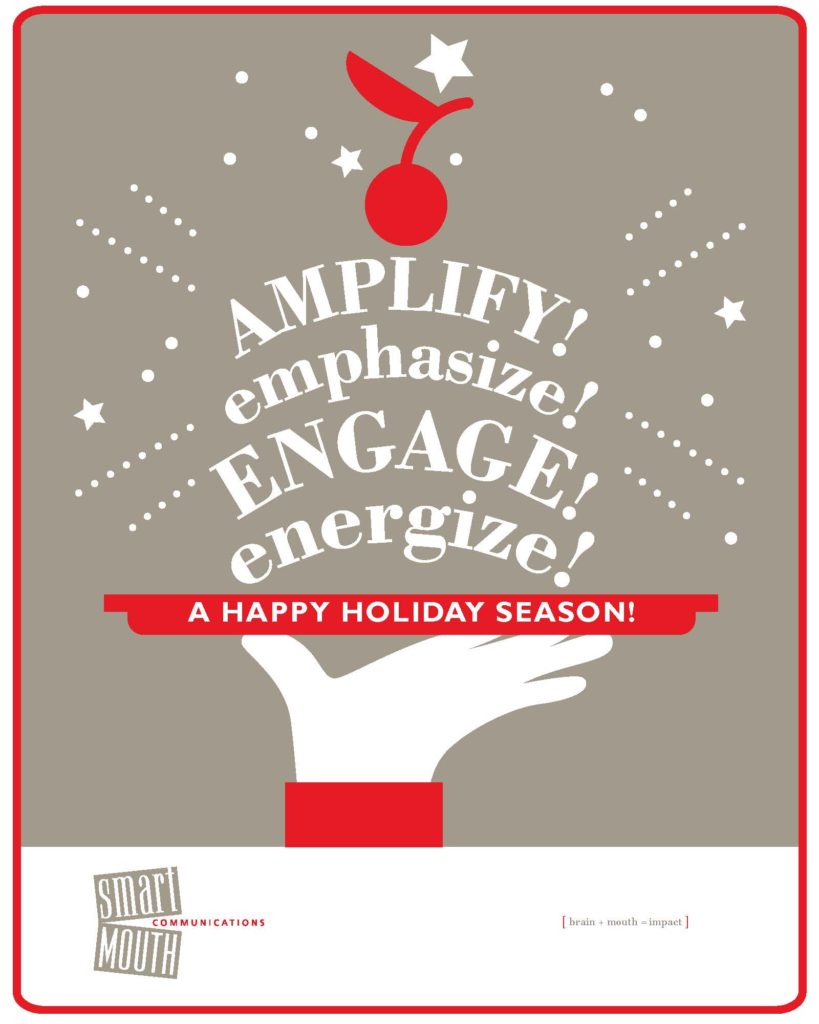by Beth Levine | Feb 20, 2019 | smartmouth talks!
 Lately, I have worked with several clients who need to share the floor or take the stage with a colleague. Each speaker rehearsed and knew their section of the presentation but, as I observed and coached them, there’s a lot more to achieving a smooth, seamless co-presenting performance than just knowing your part.
Lately, I have worked with several clients who need to share the floor or take the stage with a colleague. Each speaker rehearsed and knew their section of the presentation but, as I observed and coached them, there’s a lot more to achieving a smooth, seamless co-presenting performance than just knowing your part.
Here are 3 important agreements you and your co-presenter should discuss and make in advance:
Avoid the awkwardness of not knowing where to put yourself or what to do when it’s not your turn. When your partner is speaking, you, in effect, become a member of the audience. You turn your attention to the speaker versus staring straight at the audience while you wait. You’ll want to choreograph yourselves so that each of you, when not speaking, takes a position that defers attention to the speaker and doesn’t interfere with the screen (if using visuals). Rehearse this in the presentation space itself or block it out in a space that’s comparable.
Transitioning from one speaker to the next requires forethought and finesse. Discuss and know ahead how you will pass the baton – and practice it – as if in a relay race. Please be more interesting, engaging and collegial than merely saying, “… and now Ashley will cover the budget.” Script in some banter or repartee, or make an astute comment to summarize the link between your and your co-presenter’s material. Or, if the presentation involves a consistent back and forth every few minutes or every few slides, then make sure Speaker A’s final sentence lines up with Speaker B’s opening sentence for each transition. Avoid the duplication of effort (and tedium!) of Speaker B feeling the need to say, “… so, as Speaker A just talked about …”
Interjecting is a relief to some, undermining to others. One of the most important agreements to discuss is whether each of you prefers for your co-presenter to interject comments or questions … or not. If you forget a chunk of your material, do you want your co-presenter to chime in? Would that be helpful or would it throw you off? Are you okay fielding spontaneous comments and questions from your co-presenter to help relieve nervousness and/or to make the presentation seem more casual and collaborative? Or would that make you lose your train of thought? When I work with a co-presenting team, I always think I know who will have which preference … and I am often wrong! You never know, so discuss and agree on this in advance.
There are so many benefits to co-presenting – the change in speakers is stimulating to the audience, presenters get to share the floor and Q&A with someone who has complementary expertise, and it can be more fun for the speakers and audience alike, to name just a few. Nevertheless, because it involves two (or more) people, there’s more material, more logistics and more dynamics to consider. Discussing and agreeing on the three points above is a great way to get ahead of the game.
Bottom line: Audiences are attending one presentation, not two, so treat it that way in your planning and delivery.
by Beth Levine | Jan 15, 2019 | preparing for a presentation, public speaking
 When you prepare for a presentation, can you picture it in your mind’s eye? Do you know the elements of your opening or how you’re going to transition between your main points? Can you see it in your head, or do you need your notes?
When you prepare for a presentation, can you picture it in your mind’s eye? Do you know the elements of your opening or how you’re going to transition between your main points? Can you see it in your head, or do you need your notes?
A presentation isn’t as much a seamlessly flowing narrative as it is a deliberately well-constructed set of building blocks. For our discussion purposes here, let’s call those building blocks “chunks.” If you can chunk your material, then you have something modular, which is more easily abbreviated if your audience runs out of time and also easier for you to remember and deliver.
So what would the critical chunks of a presentation be and how would you construct them? I’m glad you asked!
First, you’ll need an opening chunk. This might include a question that stimulates the audience’s thoughts and connections to your topic. Or it might include a story that illustrates the importance of your topic. Or it might just be a simple introduction to the topic. Either way, your opening also needs to include a one-sentence focal point, in which you tell the audience what you want them to do (call to action) or to take away (impression, piece of knowledge) by the end.
Next, you’ll need to identify up to three key points. By “up to” I mean one, two or three points – and not three and a half, four or five. Yes, this means you’ll have to prioritize. You’ll be lucky if your audience can remember three, or two, or even one. So if you’re presenting with the intention and hope that your audience will retain what you say, then set a maximum of three key points. Each of your key points then becomes its own chunk, which means that with the opening chunk and up to three more, you have a maximum of four things to remember so far and you’re almost done!
Here are the ingredients of each of your “key point” chunks:
- A message statement that captures significance and/or conveys benefit for this section of your material.
- Some information points (data, detail, background) that support the message statement and that are prioritized and chosen based on your audience’s needs and interests.
- For good measure, and as a springboard to transition to your next chunk, each key point chunk should conclude with a reinforcement of the opening message statement.
Finally, your last chunk is your closing. Closing elements can include a recap of key point message statements; a story that illustrates the importance of your talk; and a circling back to your focal point to ensure that the audience knows what to do or think when they leave the room.
If you have the ability to picture five bullet points in your mind, you can see the chunks too. Try it and let us know how it goes!

by Beth Levine | Jan 2, 2019 | preparing for a presentation, public speaking

Most of us hit a personal reset button or two on the 1
st of January. But even if you aren’t someone who makes specific resolutions, you probably still view the new year as a blank slate, a chance to start fresh.
Let me help you get off to a fresh start for your first presentation of the year by offering a SmartMouth Top 10 list on this first Thursday of 2019:
10. You know this: Do your homework. Nothing drastic, just prepare ahead. If you think through your material rather than wing it, it will show and reflect well on you.
9. There’s no right or wrong, but there is better and worse. When in doubt, make decisions about your content, your visuals and the amount of time you’ll take based on your own experiences as an audience member. In other words, do unto others …
8. No one likes a windbag. Share the floor. Figure out ways to engage your audience and create opportunities for dialogue. Present, don’t broadcast.
7. Whatever you think is noticeable and distracting about you – your voice, hair, nose – it’s not. Unless you’re a paid spokesmodel, the audience isn’t paying attention to your specific physical features or your voice quality. They want to feel your confidence and hear your content.
6. Your content may be amazing, but your audience can only digest and retain some of it. Please prioritize all that great knowledge and information of yours so that you deliver something useful and memorable to your audience.
5. Present, the verb: to give something. Present, the noun: a gift. Figure out what you can give to your audience that would be a good gift – i.e. something new, useful, beneficial, valuable. Give them something good in exchange for their time and attention.
4. Your nerves are just adrenaline. They are your body’s way of surging positive energy for you to do a good job. Not to worry, studies show that nerves begin to dissipate after two minutes – that’s only 120 seconds.
3. Don’t dread your presentation, as if it’s some unpleasant obligation. Find your ambitious self and embrace your presentation as a great opportunity to advance – yourself, your organization or a goal. Go for it, don’t shrink from it.
2. Be organized: know your audience, know the lay of the land (number of people, room set-up, mic or no mic) as best you can, and know your desired outcome for the presentation. The first two help you envision what to expect. The third helps you know – if you prepare nothing else – how to set the audience’s expectations and where you need to get them by the end.
– and –
1. It’s all about them, it’s not about you. Your audience’s needs and experience supersede your own. Plan your presentation around them, not around yourself or your deep knowledge and expertise. Success is in the eye of the beholder, and that’s your audience. Make them #1.
by Beth Levine | Dec 10, 2018 | smartmouth talks!
Grateful for your continued support of SmartMouth and wishing you the very best for 2019,



by Beth Levine | Dec 4, 2018 | preparing for a presentation, public speaking
 If there were ever an invitation to “wing it” in public speaking, it would be when you’re invited to speak on a panel.
If there were ever an invitation to “wing it” in public speaking, it would be when you’re invited to speak on a panel.
Or would it?
I think this is worth discussing …
For sure, the glory/work quotient of participating on a panel is high. On the glory side, panels are great public speaking opportunities. You’re usually matched with other notables in your field, sometimes with those more notable. You get great exposure and access to a new audience. And you get to share your best nuggets of genius without bearing full responsibility for filling the time.
On the work side, the heavy lifting is typically low. Except in cases where the panel is structured, and specific subsections of the topic are assigned, most panels tend to flow freely once introductions and perhaps opening remarks are made. They’re often moderated or facilitated, there are plenty of prompts to remind you exactly what to talk about, and there’s always someone to bail you out or fill an uncomfortable silence if you trail off, forget what you were about to say, or have only a few words to offer. Sweet!
So, prepare or wing it?
To answer this dilemma, I think you need to ask yourself why you said yes in the first place. What drew you? Was it a close colleague or friend who invited you? Was it the location of the event? (ProTip: Say yes to panels in Hawaii.) Maybe it was the opportunity to get in front of a particular audience? Or maybe you said yes because the topic is so near and dear to you, speaking about it on a panel would be a breeze, almost second-nature.
Your motivation for accepting the invitation informs but shouldn’t really affect your decision to prepare or not. Would it do you great harm not to prepare? Probably not. Would it benefit you greatly not to prepare? Probably not. In other words, there’s a decent probability that not preparing has a net neutral effect. You don’t really lose, you don’t really gain.
But let’s be honest here. Net neutral is not the typical effect you look to have in your career, is it? You spend a lot of time building – your network, your reputation, your expertise, your visibility. It’s probably fair to say that if you’ve said yes to a panel invitation, there’s some net gain you’ve identified. Therefore, at least some preparation is warranted.
To that end, let’s look at some ways to prepare that don’t take a lot of time but may pack a lot of punch:
Must-air points. Given the topic, there are likely points you do not want to forget to share with the audience. Think of it as a collection of your most important thoughts on the topic – your “greatest hits” – and jot them down in bullet point form.
Differentiators. Surely you have ideas, theories, discoveries, concepts or philosophies that are unique to you/your work and would distinguish you with the audience. Decide which ones you want to share and add them to your bullet points.
Stories. You most definitely have stories – examples, anecdotes, and/or drama-filled sagas – you can share. Pick your best ones and add those to the bullet points as well. Two tips on stories: 1) unless you identify and shape/practice them in advance, you’re unlikely to conjure up and tell the perfect story on the spot; and 2) stories need to be matched up with a point you’re making, in which the point becomes the punchline to the story.
The risks associated with winging it – rambling, hemming and hawing, searching your brain for the right things to say, losing your train of thought – are too great. Being prepared – with a definitive beginning and end to your points and good stories to illustrate those points – conveys confidence, command and polish. All you need is a few bullet points and you can post your next panel in the gain column!
 Lately, I have worked with several clients who need to share the floor or take the stage with a colleague. Each speaker rehearsed and knew their section of the presentation but, as I observed and coached them, there’s a lot more to achieving a smooth, seamless co-presenting performance than just knowing your part.
Lately, I have worked with several clients who need to share the floor or take the stage with a colleague. Each speaker rehearsed and knew their section of the presentation but, as I observed and coached them, there’s a lot more to achieving a smooth, seamless co-presenting performance than just knowing your part.
 When you prepare for a presentation, can you picture it in your mind’s eye? Do you know the elements of your opening or how you’re going to transition between your main points? Can you see it in your head, or do you need your notes?
When you prepare for a presentation, can you picture it in your mind’s eye? Do you know the elements of your opening or how you’re going to transition between your main points? Can you see it in your head, or do you need your notes?
 Most of us hit a personal reset button or two on the 1st of January. But even if you aren’t someone who makes specific resolutions, you probably still view the new year as a blank slate, a chance to start fresh.
Most of us hit a personal reset button or two on the 1st of January. But even if you aren’t someone who makes specific resolutions, you probably still view the new year as a blank slate, a chance to start fresh.


 If there were ever an invitation to “wing it” in public speaking, it would be when you’re invited to speak on a panel.
If there were ever an invitation to “wing it” in public speaking, it would be when you’re invited to speak on a panel.

